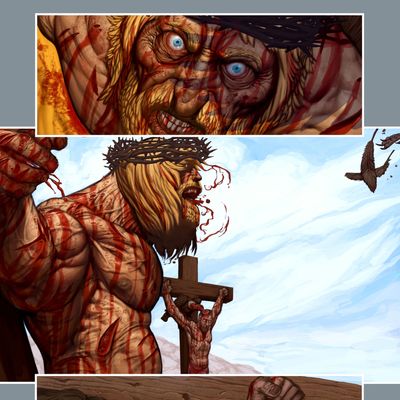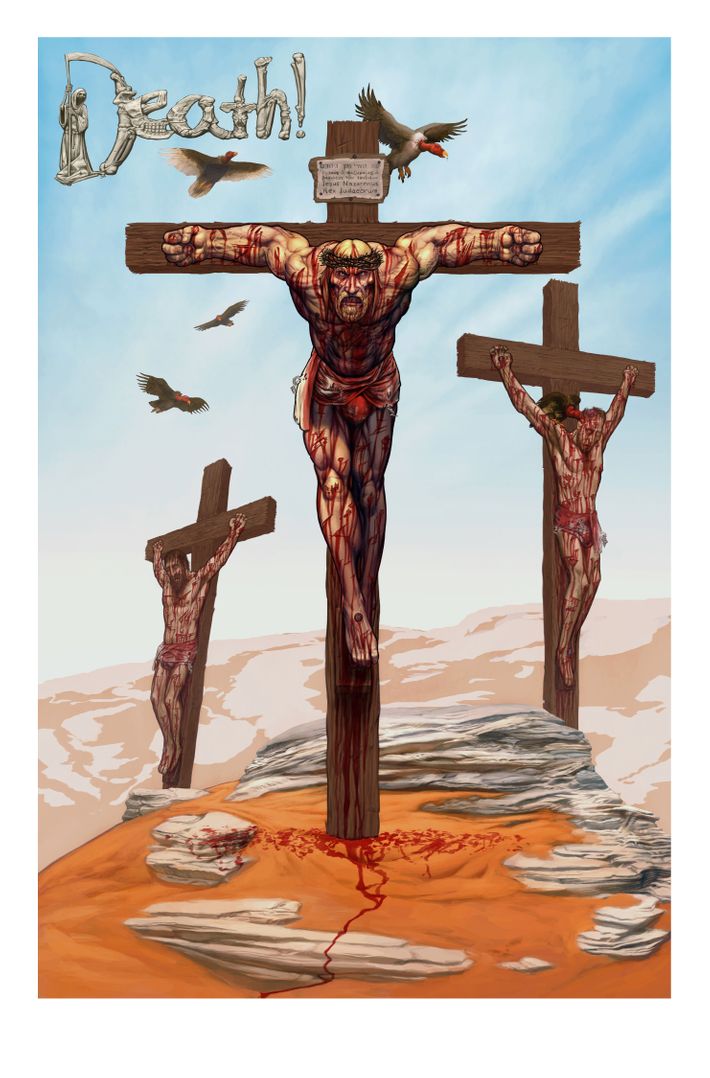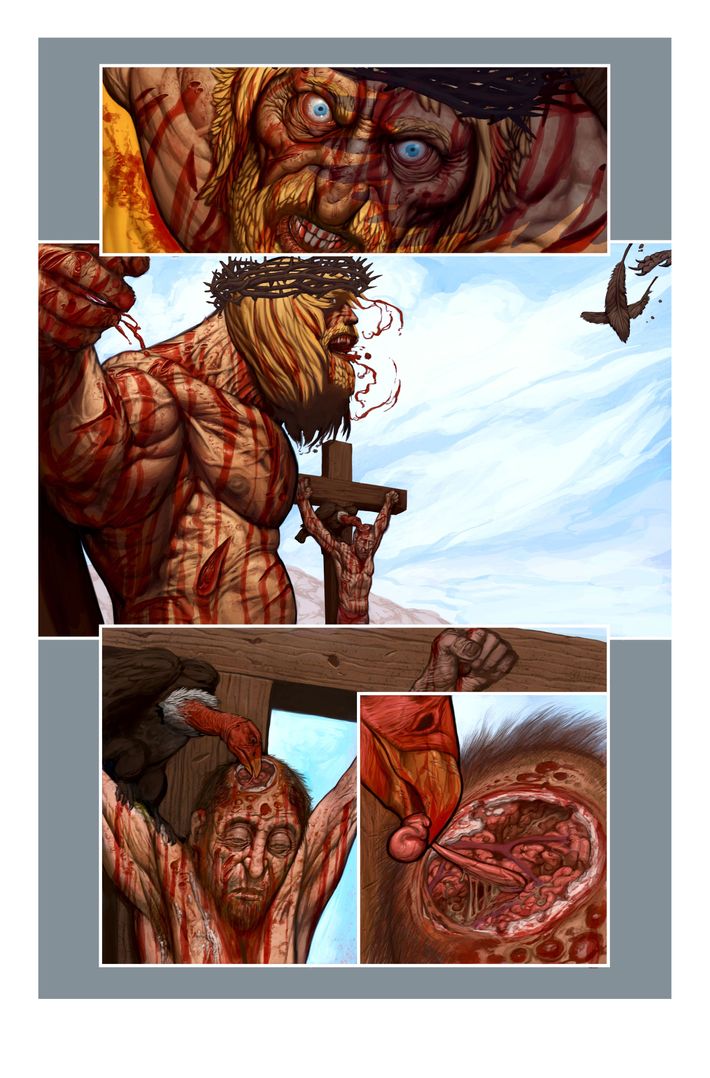
The God of All Comics is about to tackle the God of Abraham. Celebrated comics writer Grant Morrison — scribe of acclaimed works like The Invisibles, All-Star Superman, Animal Man, New X-Men, JLA, and an epic run on various Batman series — recently became the editor-in-chief of Heavy Metal magazine and has been penning stories for it, the latest of which bears the eyebrow-raising title Savage Sword of Jesus Christ. The name is a reference to a classic comics series about pulp hero Conan the Barbarian, and this strange little narrative grafts that warrior’s musculature and bloodthirsty scowls onto the Messiah.
Though one wouldn’t put it past Morrison to come up with this notion out of whole cloth, he actually found inspiration in a perverted corner of religious history: While working on his wryly provocative 1990 tale The New Adventures of Hitler, the Scotsman stumbled across the Nazi project known as Positive Christianity, which sought to recast Christ as a proactive Aryan rather than a meek Jew. In the mid-aughts, there were rumors about Morrison doing a comics-format riff on the concept, but it languished on the back burner until now. On December 28, Heavy Metal No. 284 will feature the first chapter of Savage Sword, for which we have exclusive preview art from the story’s illustrators, the Molen Brothers. We caught up with Morrison for his first interview about Savage Sword and talked about Josef Goebbels’s proto-memes, his own severely restricted internet access, and why Donald Trump’s ascent to the presidency doesn’t scare him much.
Jesus Christ may be the title character, but Der Führer makes a prominent appearance in this story. As any serious Grant Morrison fan knows, you’ve already penned a few tales about the guy. To what extent is Savage Sword of Jesus Christ a sequel to The New Adventures of Hitler?
Well, it started out as a sequel, way back in 1990, when I’d just finished that book with artist Steve Yeowell. Obviously, I had done a lot of research for that one, and I just came across this interesting idea that during the Second World War, the Nazis had attempted to rebrand Christianity, and rebrand Christ, specifically. Take him away from the gentle and peace-loving character of the Gospels, and to transform him into a Nordic and brutish and violent Messiah. Back then, I thought, “Well, there’s definitely a story in there.” But it’s taken ‘til now to do. It suddenly seemed that this was a story that was much more pertinent now than it was even then. We kind of resurrected it with these artists, the Molen Brothers.
“Resurrected” being the key word. Why do you say it’s more relevant now?
We’re living in a time when it’s quite clear how even the most pacifist stories or narratives that one time were a lot more positive, can be perverted to stand in as catalysts for violence and mayhem. Especially now that we live in a world where we’ve seen that lies can easily be overlooked, and where celebrity culture is more powerful than the truth, and where people can quite happily twist any narrative to suit any new narrative, and almost twist narratives into their complete opposites, which is what the Nazis tried to do with the Gospels.
Lies and celebrity culture. I can’t begin to imagine what you’re referring to.
I mean, we can talk about certain specific blond barbarians, but I’d like it to have wider implications. Truth has become the victim of the way the internet and the way the media has been running, and the way certain characters have been able to twist and change the story to suit themselves.

The internet is a poor medium for verification, but you’re situating this story in the context of Nazi propaganda. Is the misinformation we have now all that similar to what you’re talking about in Savage Sword?
I think that what we have now was in its infancy then. Goebbels was someone who was using early technologies like radio and film to put across his message, and he was one of the first people to realize the emotional impact that an image can have, or a sound bite can have, and the way that those can change people, the way people think, and the way it can cut through the complexities of truth to deliver a very simplistic message. What we’re seeing now is the cyber-child of that. We now have sophisticated techniques, developed by advertisers, and NLP specialists, and psychologists, over many decades.
And yet, we have to take some degree of personal responsibility for participating in this media ecosystem, no? Aren’t you phone-addicted like the rest of us?
I don’t have a phone!
You don’t?
No, I don’t. Because I’m a freelance writer who works at home, I tend not to need a phone, and my wife does all my business. She’s the one who has the phone. I’ve actually been really lucky, and insulated myself from this in a lot of ways. I don’t really have an email address at all, either. I have managed to hold out for a long time, so I do have a slight outsider’s perspective on this.
How often do you even use the internet?
I don’t use the internet much at all, except while I’m here in America, which is like four months of the year. When I do have internet access, I tend to use it for research. Back home, I live in the country in Scotland, and I can’t even get a connection in the room that I work in, which is part of an old stone building. I’m surprised that people survive it, to be honest! I prefer to just meditate, or look at the trees, or watch the ducks on the water, to be honest.
We’ve gone down a bit of a rabbit hole, so let’s climb back up to the comic. Who was coming up with this Nazi Christ stuff? Goebbels?
Goebbels didn’t come up with it, and Hitler wasn’t particularly religious, but both of them saw the value of taking control of religion, in the same way that, when the Romans invaded Britain, they took control of all the local gods, and converted them into Roman gods. One of the first things you do to control people is to control their dreams, their myths, and their stories. The Nazis didn’t go as far as the barbarian Christ — that was my innovation. All they suggested was that Christ was an Aryan, that he wasn’t from the Middle East, that he was from the north of Europe and that he was blond and blue-eyed and that he was much more proactive and violent. There is a quote from the Gospel of Matthew that says, “Think not that I am come to send peace on Earth, I come to send not peace but a sword.” They took that quote and basically used that as the basis of their attempts to recreate religion.

There is a weird correspondence between that and the latter-day stories of Jesus, and books like The Holy Blood and the Holy Grail, and some of those books that suggested that Jesus survived the crucifixion. There are conspiracy theories that Jesus survived the crucifixion, and then wound up in South America, where he became known as Kukulcan, the Feathered Serpent, which was a Mayan legend of a white man with a beard who had come across the ocean. Oddly enough, that exact same story is told in Conan the Barbarian, who was also depicted as having been crucified in a story [1934’s A Witch Shall Be Born]. It just seemed too much of a gift, especially in light of Heavy Metal and Heavy Metal imagery, to combine this notion of Conan and Jesus Christ.
I take it you were a big fan of Robert E. Howard’s Conan novels and the comics that Marvel put out in the 1970s?
Oh, yeah. As a kid, I just loved the idea of this bold barbarian who sort of came from where I lived. Conan was from the north of Britain. I guess he was sort of Scottish or Irish. I loved the idea of Conan’s journeys on the map. Robert E. Howard and other writers have fleshed out an entire life for this character.
Did you like the Schwarzenegger movie?
Everybody loves Arnold, but they never quite lived up to the comics for me. I thought the comics were probably the best version of it that I’ve seen.
You’re in L.A. right now, but were you here on Election Night?
I was, actually. It was an interesting time to be here.
And you were watching the results as they came in?
Pretty much. It was pretty obvious early on what was going to happen. The same thing had happened in Britain as well. It was a mash-up of popular feeling and anger, I think, that unfortunately expressed itself in a way that no one quite expected.
I’ve always been surprised at how optimistic you are about humanity’s future, given all the horrible nightmares you’ve written about over the years. Are you still bullish on mankind this year?
There’s a lot to be pessimistic about, but ultimately, I think humans are just part of a much wider organism, part of a much wider society, and I think what we’re actually seeing is a kind of joining up of human minds. The next couple of generations will be almost unrecognizable to us. For my generation, growing up in the Cold War, surveillance was a bad thing, and privacy was very important. But now, surveillance means that you’re a star, and to be watched means that you’re important. That’s what lies ahead, and it’s not necessarily pessimistic or optimistic, it just seems to be an undeniable fact of the way the human race is developing. I do think that ultimately, the more you connect with people, the more, hopefully, people will start to break down some of the barriers that they have just now.
As a liberal and a pacifist, aren’t you scared of what’s to come?
I don’t find these things scary. To me, as an artist, it’s new possibilities. I’m interested to see what happens and how this plays out, and how all these urges play out. It’s new ways of thinking about writing stories and new ways of it talking to the audience about what’s going on the real world, because I tend to see my stories as metaphors or symbols of how we all feel. It’s grist to the mill for me, and especially for something like this particular story which is about, as I say, the perversion of myth, the perversion of stories, the perversion of narrative. It just is really pertinent right now.
This interview has been edited and condensed.

